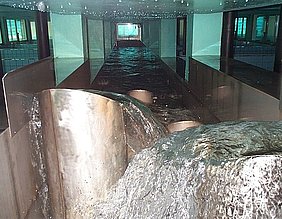The technical rule DVGW W 216 describes the mixing of drinking waters of different provenance. It names relevant parameters having influence on the properties of the mixtures regarding corrosion aspects. During a DVGW research project, which has been completed in the meantime, the scientific basis was developed, resulting in a particular need for the revision of the DVGW technical rule W 216.
Within this technical rule (W 216 “Supply with different drinking waters”) the mixing of two or more waters is conceptually regulated. The rule contains an approach, how to evaluate the difference of waters by looking at relevant chemical parameters. These are chloride, total organic carbon (TOC), phosphate, hydrogen carbonate (KS4,3), oxygen and sulphate. The rule also names technical measures how to proceed during mixing different waters, in order to avoid corrosion and quality problems.
Due to the age of the current edition of W 216 (2004) a DVGW research project was initiated with the working title “Determination of the scientific basis for the revision of the DVGW technical rule W 216 (GÜ W216)”. It was conducted by TZW: DVGW Technologiezentrum Wasser, Karlsruhe and IWW: Rheinisch-Westfälisches Institut für Wasserforschung gGmbH, Mülheim an der Ruhr to develop the relevant basics and to determine the resulting recommendations.
According to the results of the survey of some water supply companies, the specifications of W 216 seem to be interpreted very conservatively. As long as the mixed water follows the equilibrium between lime and carbonic acid in the depiction of Tillmans, corrosion problems are obviously avoidable.
With the exception of the parameter KS4.3, which has a significant relevance for chemical corrosion as it is used to calculate the mixed water situation with regard to the equilibrium of lime and carbonic acid, the provisions of exact values by the parameter scales seem to be too vague due to the complexity of various factors.
It is recommended to define the provisions concretely and network-based in a universal way and to also give recommendations for the procedure and the determination of possible technical measures. For example, when it is planned to supply a mixed water, it is recommended to first estimate the situation by a network analysis combined with a risk assessment, then adjust the flushing strategy (if applicable) and prepare optional measures like temporary dosing of a corrosion inhibitor or its step-wise alignment .
The results of the detailed investigations in the research project show a concrete demand for the revision of the DVGW technical rule W 216.
Publication:
Hesse, S.; Becker, A.; Stetter, D.: Rahmenbedingungen für die Mischung von Trinkwässern. Veröffentlichungen aus dem Technologiezentrum Wasser 96, ISSN 1434-5765, 65-80 (2021)
The volumes of the TZW publications can be ordered here.

![[Translate to English:] Prüfstelle-Produktprüfung_Teststand Test centre and product testing](/fileadmin/_processed_/0/9/csm_TZW-Karlsruhe_Pruefung_Geraete-Teststand_377188946c.jpg)
























